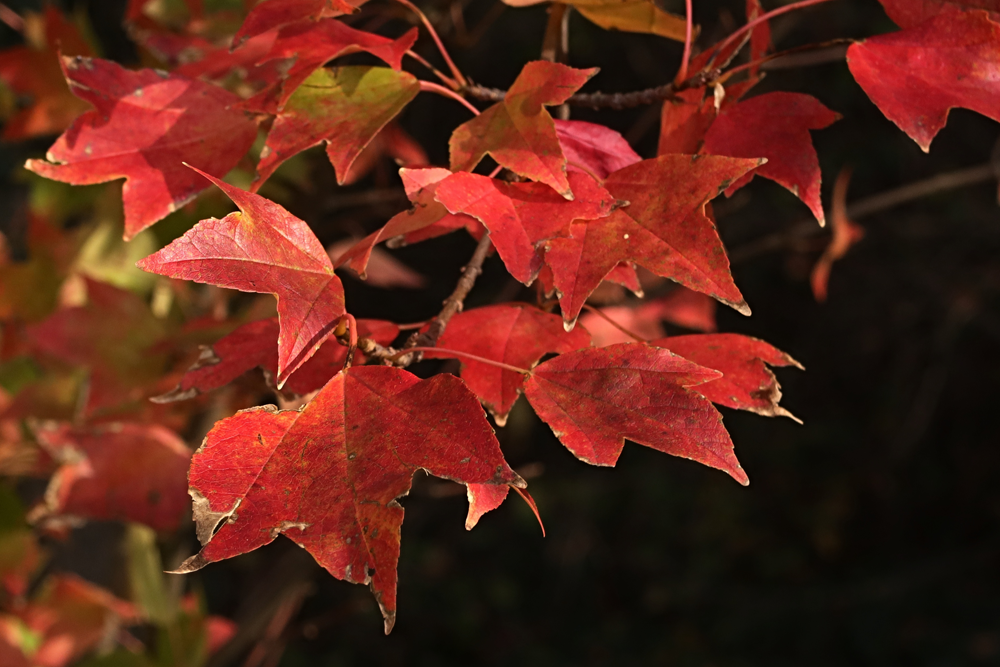Acer buergerianum
Common Name:
Trident maple

General information:
This deciduous, 30 to 45-foot-high by 25-foot-wide tree in the wild, has beautiful 3-inch-wide, tri-lobed leaves, glossy green above and paler underneath, which turn various shades of red, orange, and yellow in autumn. Flowers are bright yellow and showy in the spring. Trident Maple naturally exhibits low spreading growth and multiple stems but can be trained to a single trunk and pruned to make it branch higher, allowing passage below its broad, oval to rounded canopy. With its moderate growth rate, attractive orange-brown peeling bark, and easy maintenance, Trident Maple is popular as a patio or street tree and is also highly valued as a bonsai subject. Crown form is often variable and selection of a uniformly- shaped, vigorous cultivar is needed. The trident maple is a very popular species for bonsai, due to its small, three-lobed leaves, a readily-thickening trunk, and thick, gnarly roots which adapt well to root-over-rock style.
Family:
Aceraceae
Lighting:
USDA states that this tree will grow in full sun, part sun or part shade. Tomlinson, writing from the UK, believes this maple needs full sun. Simon and Schuster recommends partial shade.
Temperature:
Although hardy in zones 4B through 9, the trident maple’s roots have a high moisture content, and are susceptible to frost damage. This is a potentially fatal problem experienced by members of the Internet Bonsai Club and warned against in almost every book. Tomlinson goes so far as to suggest the substitution of Acer ginnala, the Amur maple, in colder areas. At the very least, this tree should be carefully winter protected.
Watering:
Water moderately in summer, easing off in winter.
Feeding:
Tomlinson, as he usually does, suggests an aggressive feeding schedule: once weekly for the first month after leaves appear, then every two weeks during growth. Simon and Schuster recommends feeding every three weeks during growth, with an interval in midsummer. I’ve used the more conservative schedule with my tree and have been happy with its growth, but find it entirely possible that more frequent feeding would improve the vigor of the tree. More frequent feeding, however, requires increased vigilance in pinching back. If a liquid fertilizer is used, it should not be sprayed on the leaves, as this may result in leaf burn.
Pruning and wiring:
Pinch back new growth to the first two leaves. The tree may be wired at any time during growth, but the branches are somewhat brittle and it is also wise to provide some protection for the bark. The tree, given ample pot space, will grow rapidly, so it is essential to continually check the wire to avoid scarring. Leaf pruning can be carried out in midsummer to miniaturize foliage. Make certain that the tree is healthy and vigorous before leaf pruning. Total leaf pruning should not be carried out annually, as the tree needs a year to restore its stores of energy. I’ve been told that it’s safer to leaf prune gradually, removing only 1/3 to 1/2 of the tree’s largest leaves at a time. The trident’s leaves reduce readily, but it is more difficult to get short internodes and finely ramified branches. For the more advanced/courageous among us, Brent Walston suggests: For smaller pieces, in one gallon training pots, I let them grow wild for 2 or 3 years until the roots completely fill the pot and there is a noticeable decline in vigor. The internodes shorten and the leaves get smaller. It is at this point that I do major pruning shortening them to under a foot. The depleted state of the roots due to the root-bound conditions prevents them from forming the typical coarse growth that usually results following such a pruning. Performing this operation in summer will have an even more dramatic effect, since in essence it is a radical (very radical) defoliation. Root pruning and repotting can take place at the same time. As Michael Persiano would say, these are not procedures for beginners. Once they are potted up and the final branches are selected, several defoliations a season will result in the short internodes and small leaves so desired.
Propagation:
Trident maple can be grown from seed, air-layered, or grown from both hardwood and softwood cuttings. Tomlinson says that even wrist thick cuttings may take, and one instance of a six-inch (!) cutting being rooted successfully has been reported. Best results are achieved taking cuttings in late winter-early spring for hardwood and midsummer for softwood. Seeds require a 24 hour hot water soak, then cold-moist pretreatment for three months. Seeds need to be stored refrigerated, which will start the cold- treatment process. Seeds kept in dry storage are tough to activate, resulting in a poor percentage of germination. If you cannot collect your own seed, it seems that purchasing fresh, properly stored seed from a reputable dealer is essential.
Repotting:
In spring, before buds open. Roots grow very quickly, so annual repotting may be necessary for young trees; older trees tend to need repotting every 2-3 years. If root die-back has occurred during the winter, trim off old root matter to allow room for new growth. Tomlinson recommends a fast-draining soil mix; The USDA states that Trident Maple should be planted in any well-drained, acid soil and is quite tolerant of salt, air pollution, wind and drought. Like other maples, some chlorosis can develop in soils with pH over 7 but it is moderately tolerant of soil salt.
Pests and diseases:
Generally pest and disease free, but are vulnerable to caterpillar attack.
Species/varieties which make excellent bonsai:
Acer b. formosanum, the Taiwan or Formosan Trident.
“Mino Yatsubusa” and “Miyasama Kaede Yatsubusa”, which exhibit various characteristics of being dwarfed.
“Goshika Kaede,” a variegated form.
“Nartua Kaede” and “Tancho”, two with unusual rolled-edged leaves. “Evergreen’s Rough Bark,” valued for its bark appearance.
Bibliography:
Complete Book of Bonsai by Tomlinson The Simon and Schuster Guide to Bonsai USDA Fact Sheet ST-9
Compiled by Sabrina Caine
Edited by Michael Johnson and Thomas L. Zane
